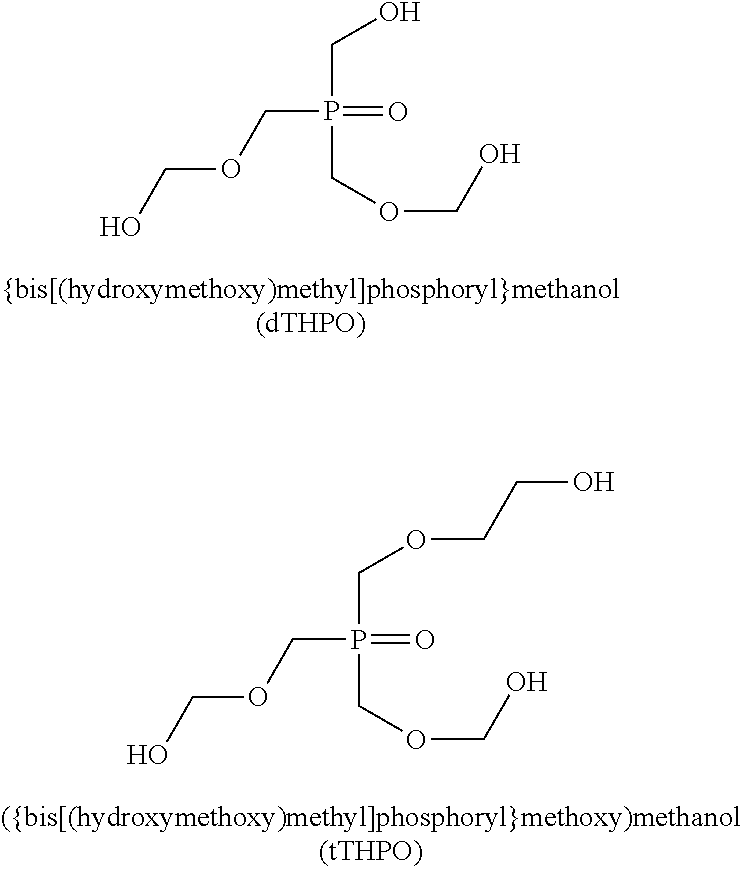Stable modified polymer polyol dispersions
a polymer polymer and dispersible technology, applied in the field of stable modified polymer polyol dispersions, can solve the problems of genotoxic carcinogen, high reactive formaldehyde, adverse health effects,
- Summary
- Abstract
- Description
- Claims
- Application Information
AI Technical Summary
Benefits of technology
Problems solved by technology
Method used
Image
Examples
working example 1
According to the Invention
[0352]A solution of KOH with a concentration of 0.172 g / mL was prepared by dissolving 87.1 g of KOH in 420 ml of ethanol. 320 mL of this solution was added slowly over 325.2 g of THPS solution (76.1%). After complete precipitation, the sulfate salt was filtered out and the filter cake was washed with additional 100 ml of pure ethanol. The distillation was performed using a rotavapor. The filtered solution was poured into a 1 L flask and introduced into a hot oil bath setted at 100° C. for one hour while pressure was gradually reduced until 50 mbar. 147 g of product were collected.
[0353]Table 6 shows the composition of the different phosphorus based species. Other minor components may be present.
TABLE 6mol %THPOTHPSTHPm-THPd-THPt-THP7.83.961.624.02.50.1
[0354]A solution of THP derivatives and urea was prepared by mixing 46.50 g of the mixture of phosphorus compounds, prepared in this example, 33.76 g of urea and 50 mL of water. This solution was added, under ...
working example 2
Aaccording to the Invention
[0356]A solution of KOH with a concentration of 0.1808 g / mL was prepared by dissolving 87.04 g of KOH pellets (Sigma Aldrich) in 420 ml of ethanol. 320 mL of this solution was added slowly over 325.2 g of THPS solution (76.1%). After complete precipitation, the sulfate salt was filtered out and the filter cake was washed with additional 100 ml of pure ethanol. The distillation was performed using a short path distillation device (model “KDLS”, manufactured by UIC GmbH), under the conditions of a temperature of heating surface (temperature of thin film) of 130° C., a pressure of 10-11 mbar, a rotor revolution of 300 rpm, and a feeding rate of about 10 mL / minute to perform the thin film distillation. 101 g of product were collected.
[0357]Table 7 shows the composition of the different phosphorus based species. Other minor components may be present.
TABLE 7mol %THPOTHPSTHPm-THPd-THPt-THP17.37.171.80.40.00.0
[0358]A solution of THP derivatives and urea was prepar...
example a
Preparation of Polyurethane Foams
[0360]A batch was prepared mixing water, amines, DEOA and Ortegol 204 according to the foam formulation shown in the table 13. Polyols and silicone were mixed for 50 seconds at 5000 rpm into a cardboard glass. The corresponding quantity of batch was added to the mixture, and after 5 seconds the tin octoate was added and stirred for 5 more seconds. Then the isocyanate was added and stirring was maintained for 10 seconds.
[0361]The resulting mixture was poured into a 30.4×21.8×16.7 cm aluminum mold protected by kraft paper at 23° C. and the mixture was allowed to react in the mold for a period of 5 minutes, rise profile was monitored by a Foamat equipment. The resulting foam was removed from the mold, and allowed to cure in an oven at 100° C. for 15 minutes. After that curing step the foam was storaged at 23° C. and 50% relative humidity for at least 24 h.
[0362]Table 8 shows the compositions of a PU foam comparative example 1, and PU foam working exampl...
PUM
| Property | Measurement | Unit |
|---|---|---|
| concentration | aaaaa | aaaaa |
| mol % | aaaaa | aaaaa |
| Flexible | aaaaa | aaaaa |
Abstract
Description
Claims
Application Information
 Login to View More
Login to View More - R&D
- Intellectual Property
- Life Sciences
- Materials
- Tech Scout
- Unparalleled Data Quality
- Higher Quality Content
- 60% Fewer Hallucinations
Browse by: Latest US Patents, China's latest patents, Technical Efficacy Thesaurus, Application Domain, Technology Topic, Popular Technical Reports.
© 2025 PatSnap. All rights reserved.Legal|Privacy policy|Modern Slavery Act Transparency Statement|Sitemap|About US| Contact US: help@patsnap.com



